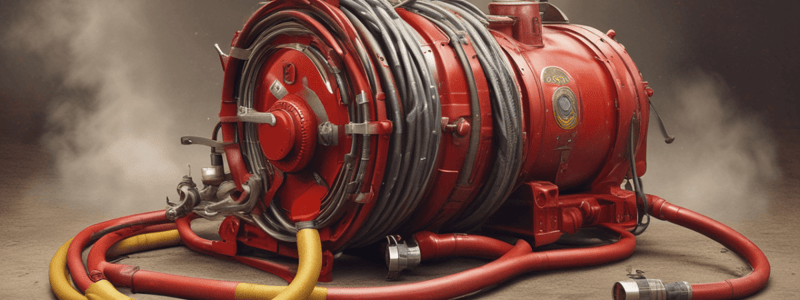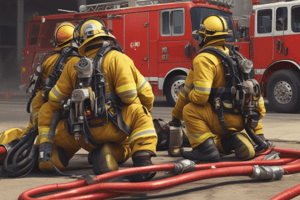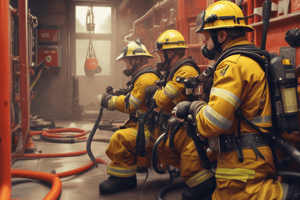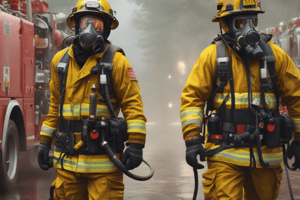Podcast
Questions and Answers
What is the flow rate delivered by the 7/8" tip?
What is the flow rate delivered by the 7/8" tip?
- 160 GPM (correct)
- 200 GPM
- 130 GPM
- 210 GPM
Which series of Elkhart tips is currently used for the 7/8" tip?
Which series of Elkhart tips is currently used for the 7/8" tip?
- Legacy Series
- XP Series
- Alpha Series
- XD Series (correct)
What is the diameter of the inlet for the 2 1/2" shut-off?
What is the diameter of the inlet for the 2 1/2" shut-off?
- 2 inches
- 1 inch
- 2.5 inches (correct)
- 1.5 inches
What is a distinguishing feature of the Legacy series shut-off bale?
What is a distinguishing feature of the Legacy series shut-off bale?
Which district bundle utilizes the 1" tip paired with a 1 1/8" tip?
Which district bundle utilizes the 1" tip paired with a 1 1/8" tip?
Which GPM can the 1" tip assembly deliver?
Which GPM can the 1" tip assembly deliver?
What is the primary supply hose used by the District?
What is the primary supply hose used by the District?
For which type of incident is a booster hose primarily used?
For which type of incident is a booster hose primarily used?
What length of booster hose is carried on District engines?
What length of booster hose is carried on District engines?
What is a primary characteristic of hard suction fire hose?
What is a primary characteristic of hard suction fire hose?
What is the diameter of the hard suction carried by District engines?
What is the diameter of the hard suction carried by District engines?
How is the hard suction hose of the reserve tender different from that of the District engines?
How is the hard suction hose of the reserve tender different from that of the District engines?
What is the diameter of the Key Combat Sniper hose?
What is the diameter of the Key Combat Sniper hose?
Which feature helps to visually distinguish the Key Combat Sniper 1.78" hose?
Which feature helps to visually distinguish the Key Combat Sniper 1.78" hose?
How can the Key Combat Sniper 1.78" hose be carried?
How can the Key Combat Sniper 1.78" hose be carried?
What is a notable advantage of the Key Combat Sniper 1.78" hose?
What is a notable advantage of the Key Combat Sniper 1.78" hose?
What important function does the Key Combat Sniper 1.78" hose serve?
What important function does the Key Combat Sniper 1.78" hose serve?
Which other hose color pattern is NOT used to distinguish the Key Combat Sniper hose?
Which other hose color pattern is NOT used to distinguish the Key Combat Sniper hose?
Flashcards are hidden until you start studying
Study Notes
Hose Types
- Key Combat Sniper 1.78" double jacket hose is the preferred choice for handheld attack lines, small enough for one firefighter to operate, with an effective fire stream delivery.
- 5" LDH is the primary supply hose, delivering large volumes with minimal friction loss, preferred for operating from a hydrant.
- Booster hose is used for brush fires, overhaul, and decontamination, available in 100' lengths, and carried on reels.
- Hard suction hose is used for drafting water from a static source, rigid in construction, and available in 6" diameter (10' lengths) and 4" diameter (reserve tender).
Firefighting Equipment
Tips and Nozzles
- 7/8" tip is the primary tip for small diameter attack lines, delivering 160 GPM, with a 1.5" inlet.
- 2 1/2" shut-off is used with corresponding tips and nozzles, available in Elkhart Brass Legacy and XD series, with a 2.5" inlet and 1.5" outlet.
- 1" tip is used in two types: single construction (Marine Firefighting Context Manual) and two-piece assembly (Denver Bundles), delivering 210 GPM, with male threads, and paired with 1 1/8" tip and 2 1/2" shut-off.
Studying That Suits You
Use AI to generate personalized quizzes and flashcards to suit your learning preferences.



